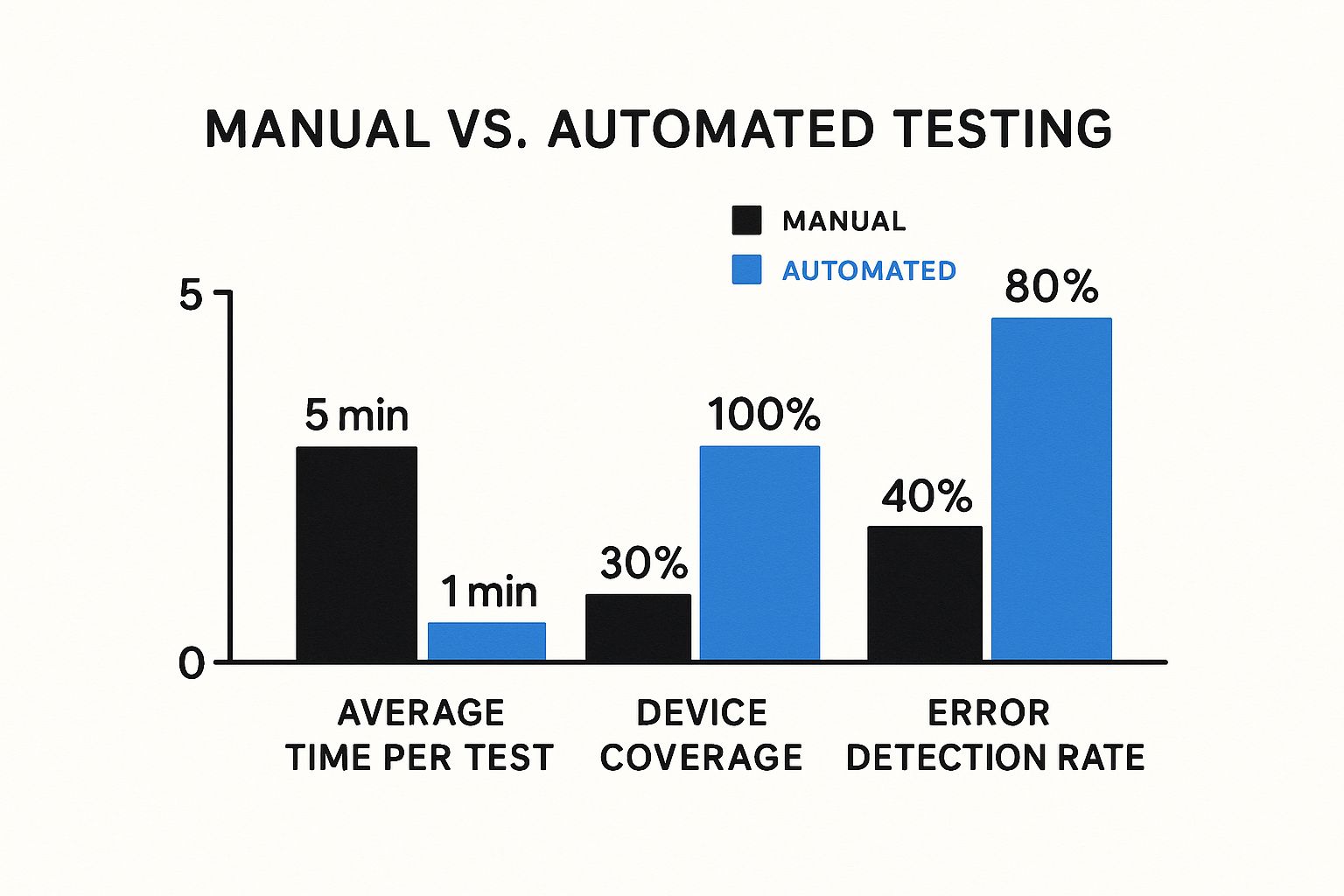Why Checking Your Website Across Devices Is Non-Negotiable
The online world has evolved beyond the desktop. Users now seamlessly switch between smartphones, tablets, and laptops throughout their day, expecting a consistent experience on every device. This makes cross-device website testing essential for online success. Ignoring this can fracture the user experience, harming your brand and impacting your bottom line.
The Mobile-First World and Beyond
Mobile browsing's rise is undeniable. As of February 2025, mobile devices generated 63.05% of global website traffic, with Africa leading at 69.13%. This reflects the global shift towards mobile-first browsing, fueled by affordable smartphones and expanding 5G networks. Users now spend an average of 3 hours 46 minutes daily on mobile internet, compared to 2 hours 52 minutes on desktops, emphasizing the need for responsive design. YouTube sees 87.35% mobile traffic, while Wikipedia reports 76.86%, further establishing mobile as the primary access point. Explore this topic further. While prioritizing mobile responsiveness is key, it's just the first step.
Consider the growing popularity of tablets and the diverse screen sizes within each device category. A website optimized for an iPhone might be challenging to navigate on a larger Android phone or unusable on a tablet. Therefore, testing across various screen sizes and resolutions is vital.
The Cost of Incompatibility
Website incompatibility on a specific device can have immediate consequences. Imagine a potential customer encountering a distorted layout and unresponsive buttons on your e-commerce site. This negative experience can lead to lost sales and damage your brand's reputation.
Poor mobile experiences also negatively impact search engine rankings. Google prioritizes mobile-friendly websites, meaning incompatibility can decrease search visibility. This, in turn, reduces organic traffic and hinders your overall online presence.
Evolving User Expectations
Today's users expect seamless and intuitive experiences, regardless of access method. They value responsive design, fast loading times, and easy navigation. Failing to meet these expectations can lead to frustration and drive users to competitors.
Think of it like visiting a physical store. You expect consistent service and product availability across locations. Similarly, your website should offer a consistent, high-quality experience across all devices, strengthening your brand and building customer loyalty. Checking your website across devices helps meet these evolving expectations, establishing a robust online presence.
Essential Tools To Check Website On Different Devices
Ensuring your website displays and functions correctly across a range of devices is crucial for success. This means testing on desktops, laptops, tablets, and smartphones. Fortunately, several tools are available, both free and premium, to simplify cross-device compatibility checks. These tools help identify and address issues before they impact your users.
Browser-Based Developer Tools For Quick Checks
Modern web browsers offer built-in developer tools perfect for initial website checks. Chrome DevTools (Chrome DevTools) and Firefox Responsive Design Mode (Firefox Responsive Design Mode), for example, allow you to preview your website on various screen sizes. You can simulate different devices, orientations, and resolutions directly in your browser. This is particularly helpful during development for catching layout issues early. Keep in mind, however, that these tools don't perfectly replicate real devices, so further testing is necessary.
Comprehensive Device Simulation With Dedicated Platforms
For more in-depth testing, platforms like BrowserStack (BrowserStack), CrossBrowserTesting (CrossBrowserTesting), and Responsinator (Responsinator) offer comprehensive device simulation. These platforms provide access to a wide array of real devices and browsers, ensuring accurate testing across diverse environments. BrowserStack, for instance, lets you test on different operating systems and older browser versions, offering a highly accurate view of compatibility. While valuable, these platforms often come with subscription fees.
For a more detailed look into mobile website testing best practices, check out this resource: How to Master Mobile Website Testing.

Emerging AI-Powered Testing Solutions
Beyond established tools, AI-powered testing solutions are emerging to further simplify cross-device testing. These tools automatically scan for compatibility issues, flagging potential problems. They act as automated quality assurance, identifying discrepancies that might be missed during manual tests. This technology has the potential to make testing more efficient and effective, saving time and resources.
The following table summarizes the different types of tools available for device testing:
Device Testing Tools Comparison
A comprehensive analysis of the most effective cross-device testing tools, with details on capabilities, pricing models, and best-fit scenarios
| Tool Name | Type | Key Features | Price Range | Best For | Limitations |
|---|---|---|---|---|---|
| Chrome DevTools | Browser-based | Simulates various screen sizes, orientations, and resolutions | Free | Quick checks during development | Doesn't fully replicate real devices |
| Firefox Responsive Design Mode | Browser-based | Similar to Chrome DevTools | Free | Quick previews across different screen sizes | Limited device and browser options |
| BrowserStack | Cloud-based | Access to a wide array of real devices and browsers, including older versions and different operating systems | Paid (subscription) | Comprehensive cross-browser and cross-device testing | Can be expensive for smaller projects |
| CrossBrowserTesting | Cloud-based | Similar to BrowserStack, with visual testing and debugging tools | Paid (subscription) | Detailed testing in various environments | Subscription cost |
| Responsinator | Web-based | Quick previews on different device screens | Free | Basic responsive design checks | Limited features and detailed testing capabilities |
| AI-powered testing tools (emerging) | Cloud-based / AI-driven | Automated scans for compatibility issues, flagging potential problems | Varies | Automated, large-scale testing | Technology is still evolving |
The table above highlights the pros and cons of each tool, allowing you to choose the best fit for your project. From free browser-based tools to comprehensive paid platforms and emerging AI-powered solutions, there are options to suit every need and budget.
Choosing The Right Tools For Your Needs
Selecting the right tool depends on your budget, required testing depth, and technical skills. Browser-based tools are great for free, quick checks, while dedicated platforms provide more comprehensive results. As AI-powered testing develops, it offers a promising future for automated, extensive testing. By understanding the strengths and weaknesses of each approach, you can build a testing strategy that meets your specific needs. The right combination of tools ensures a consistent, engaging experience for your users across all devices.
Understanding Device Usage Patterns That Impact Testing
Thoroughly testing your website on various devices isn't just good practice; it's essential. But efficient testing starts with understanding your audience's access patterns. This means analyzing device usage and recognizing how browsing habits differ across regions, demographics, and industries.
The Mobile vs. Desktop Balancing Act
The idea that mobile has entirely replaced desktop browsing is inaccurate. While mobile use is increasing, desktops remain relevant, especially in certain situations. For instance, many workplaces still rely heavily on desktop computers because of existing software and workflows. This distinction reinforces the importance of checking your website on different devices to serve both mobile and desktop users.
Content type also influences device preference. While social media and quick searches are mainly mobile activities, complex data analysis, extended writing, or graphic design often occur on the larger screens and more powerful processors of desktops. Therefore, your testing strategy should consider your content's nature and your target audience’s preferred access methods.

As of late 2024, desktop usage has fallen to 61.5% of global internet users, down from 72.3% in early 2020. However, regional differences are substantial. Europe, for example, maintains 75.5% laptop/desktop usage, mainly due to workplace norms and digital infrastructure. Conversely, emerging markets often prioritize mobile-first approaches. Significantly, 26.8% of computer users access the internet through employer-provided devices, highlighting the ongoing need for enterprise platform testing. For further statistics, see DataReportal's digital 2025 device trends report.
Beyond Mobile and Desktop: The Screen Size Spectrum
Even within device categories, screen size variations create additional testing challenges. The user experience on a small smartphone differs drastically from that on a large-screen phone, a foldable device, or a tablet. Similarly, desktop users range from those with standard monitors to those with ultra-wide displays. This range of screen sizes emphasizes the need to test beyond simple mobile/desktop classifications. You might find this article helpful: How to Master Website Performance Testing.
Visualizing Device Usage: A Data Chart Breakdown
To better understand these complexities, the following data chart breaks down device usage across key regions by mobile, desktop, and tablet percentages.
Global Device Usage Breakdown
Current statistics revealing how website visitors access content across different devices and geographical regions
| Region | Mobile (%) | Desktop (%) | Tablet (%) | Key Trends |
|---|---|---|---|---|
| North America | 65 | 30 | 5 | Mobile dominance, slow tablet growth |
| Europe | 55 | 40 | 5 | Strong desktop presence, low tablet use |
| Asia | 70 | 25 | 5 | Rapid mobile growth, emerging tablet market |
| Africa | 75 | 20 | 5 | Mobile-first ecosystem |
| South America | 68 | 27 | 5 | Mobile-centric with increasing desktop use |
This chart reveals some key takeaways, such as mobile's continued dominance in Africa and Asia, while North America shows a more balanced split. The consistently low tablet usage across regions suggests that, while testing for tablets is important, they might not require the same focus as mobile and desktop, depending on your audience. Understanding these trends allows for prioritizing testing efforts and resource allocation, ensuring a seamless user experience for most of your visitors.
Step-by-Step Process To Check Website On Different Devices

Checking your website on different devices is essential for a positive user experience and maximizing your reach. It's more than a best practice; it's a necessity. This section provides a practical, step-by-step process for evaluating your website's performance and appearance across various devices.
Planning Your Cross-Device Testing Strategy
Before testing, define clear objectives. Identify the key user journeys, like completing a purchase or submitting a contact form. This focused approach ensures you test the most critical functions. Also, determine which devices and browsers to prioritize based on your target audience's usage.
Executing Your Tests: Three Key Methods
You can use three primary methods for checking your website on different devices.
-
Physical Devices: Testing on actual devices offers the most accurate representation of user experience. You can assess real-world performance, including touch interactions and device-specific features.
-
Emulators and Simulators: These software tools mimic different devices and operating systems. This offers a cost-effective alternative to physical devices, though they may not perfectly replicate real-world performance.
-
Dedicated Testing Platforms: Cloud-based services like BrowserStack provide access to various real devices and browsers. These platforms offer comprehensive testing environments, including different operating system versions and network conditions.
Key Checkpoints During Testing
Regardless of your chosen method, these checkpoints are crucial:
-
Layout Integrity: Ensure your website's layout adapts to different screen sizes and orientations. Check for distorted elements, overlapping content, and horizontal scrolling.
-
Navigation Usability: Verify that navigation remains intuitive and easy to use on all devices. Test menus, links, and interactive elements.
-
Content Readability: Assess content readability on different screens. Check font sizes, line heights, and text contrast.
-
Interaction Elements: Confirm that buttons, forms, and other interactive elements function correctly on touchscreens and with different input methods.
-
Performance Metrics: Evaluate loading times, page speed, and overall performance across various devices and network conditions.
By November 2024, mobile traffic accounted for 64.04% globally, with tablets at 2.20%. Platforms like Reddit saw significantly more mobile visits (5.9B) than desktop (1.67B), while others like ChatGPT showed near parity. For more statistics, see: Mobile Internet Traffic Statistics. This data underscores the importance of device-specific optimization.
Documenting, Prioritizing, and Implementing Fixes
Document any issues with screenshots and descriptions during testing. This helps prioritize fixes based on their impact. Implement solutions and retest to confirm resolution.
Establishing a Sustainable Testing Schedule
Integrate cross-device testing into your regular workflow. Schedule regular checks, especially after website updates or redesigns. This ongoing process ensures consistent, optimal experiences across all devices. Even minor content updates can sometimes cause unexpected layout or functionality issues. A sustainable testing schedule proactively catches and resolves these problems.
Solving Common Cross-Device Issues Like the Pros
Building a website that looks great on every device can be challenging. Even with meticulous planning, cross-device compatibility problems can arise. That's why checking your site's responsiveness isn't a one-time task, but rather an ongoing process. This section explores common cross-device issues and provides practical solutions you can implement right away.
Tackling Layout Breakdowns
One of the most frequent issues is layout breakdown. This occurs when a website's layout appears distorted or broken on different screen sizes. Imagine a perfectly aligned image gallery on your desktop computer looking scattered and disorganized on a mobile phone. This often stems from problems with breakpoints, the points at which a website's layout adjusts for different screen sizes. Utilizing a responsive design framework like Bootstrap or Tailwind CSS can effectively manage these breakpoints and ensure a smooth layout across various devices.
Overcoming Touch Interface Challenges
Websites designed for mouse and keyboard navigation can be difficult to use on touchscreens. Buttons might be too small to tap accurately, and interactive elements may not respond correctly to touch gestures. This can be especially frustrating for users on smaller mobile devices. The key is to design with touch in mind from the beginning. Make sure buttons are appropriately sized and spaced, and implement touch-friendly gestures like swiping and pinching.
Prioritizing Content For Smaller Screens
Mobile devices have limited screen space, which requires careful content prioritization. Not everything that fits on a desktop screen is essential for mobile users. Think of it like packing a suitcase: you prioritize essential items due to limited space. Similarly, on mobile, core content, calls to action, and essential navigation elements should take precedence. Less critical content can be hidden or moved lower on the page.
Addressing Mobile Network Performance Bottlenecks
Slow loading times on mobile networks can lead to user frustration and higher bounce rates. Images, videos, and other media files often contribute to these performance issues. Optimizing these files for mobile using techniques like compression and lazy loading is essential for a fast and enjoyable mobile experience. For a deeper dive into mobile optimization, check out this article on How to master making your website mobile-friendly.
Handling Device-Specific Features
Modern devices like those with notches and foldable displays introduce additional design complexities. Content can sometimes be obscured or distorted on these devices. Testing on physical devices or using accurate emulators is crucial for addressing these device-specific features. You might also find this resource helpful: How to Master Mobile Website Testing.
Ensuring Consistent Typography Across Platforms
Typography can render differently across various devices and operating systems, impacting readability and visual appeal. Using web-safe fonts or specifying fallback fonts helps create a more consistent typographic experience across all platforms.
Preventative Design: Minimizing Cross-Device Issues
Reactively addressing cross-device issues can be time-consuming and expensive. Preventative design minimizes these problems from the outset. This involves adopting mobile-first design principles, using responsive frameworks, and incorporating thorough cross-device testing throughout the development process. This proactive approach helps identify and resolve potential problems early on, resulting in a consistent and user-friendly experience on all devices. Regularly auditing your website is also essential for catching emerging cross-device issues.
Advanced Testing Strategies for High-Stakes Websites

For websites handling complex functionality or mission-critical user experiences, simply testing on a few different devices isn't enough. A more comprehensive and advanced testing strategy is essential to guarantee optimal performance and user satisfaction. This is particularly important for websites featuring dynamic content, multi-step processes, or interactive elements that behave differently across various devices.
Automated Testing Frameworks for Efficiency
Implementing automated testing frameworks is vital for high-stakes websites. These frameworks empower you to execute tests automatically across numerous devices and browsers, significantly reducing manual testing time. Tools like Selenium and Cypress can automate user interactions, such as form submissions and checkout flows. This automation allows you to swiftly verify website functionality across a range of devices. It's particularly beneficial for regression testing after code changes, ensuring existing features remain unbroken.
Simulating Real-World Network Conditions
Testing under diverse network conditions is crucial for ensuring your website performs well for everyone. Not all users have access to high-speed internet. Slow loading times can severely impact user experience. Tools like BrowserStack enable you to simulate different network speeds, from 3G to 4G and even slower connections. Simulating these conditions allows you to pinpoint potential performance bottlenecks and optimize your website for users in areas with limited connectivity.
Accessibility Compliance Across Devices
Accessibility is a fundamental aspect of web design, ensuring your website is usable by people with disabilities. Testing for accessibility involves checking factors like appropriate use of ARIA attributes, keyboard navigation, and color contrast. Validating accessibility compliance across different devices is essential, as some assistive technologies interact differently with websites depending on the platform. Automated accessibility testing tools can streamline this process, highlighting areas for improvement and guaranteeing inclusivity for all users.
A/B Testing and User Testing Across Devices
A/B testing, where different versions of a webpage are presented to users to identify the best performer, is another key advanced testing technique. Conducting A/B tests across devices helps determine the most effective design and content for each platform. Furthermore, user testing with real people on multiple devices provides invaluable feedback on the actual user experience. This qualitative data can uncover usability problems that might be overlooked during automated testing.
Continuous Integration for Seamless Cross-Device Testing
For complex websites, establishing continuous integration (CI) workflows is highly recommended. CI automatically tests code changes as they are implemented, incorporating cross-device compatibility checks into the development process. This helps identify and resolve compatibility issues early, before they reach production. This proactive approach ensures a streamlined development cycle while upholding a high-quality user experience across all devices. This integrated approach to cross-device validation is particularly beneficial for enterprise applications, media-rich websites, and progressive web apps (PWAs), which often involve complex user interfaces and interactions.
Ready to elevate your website auditing and impress your clients? Roast My Web offers AI-powered website auditing tailored for freelancers and agencies. Automate comprehensive audits, produce client-ready reports, and gain actionable insights to enhance website performance. Check out Roast My Web today!



